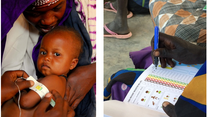Report
- Community scorecards are often conceived as a tool to exact greater accountability and responsiveness from services providers, as well as being a strong instrument for community empowerment. However, little is known about the impact of this type of social accountability tool, and even less so in conflict-affected and fragile contexts like that of eastern Congo.
- This brief attempts to capture one such effort to better understand the community scorecard by describing its methodology and sharing learning emerging from the Most Significant Change (MSC) technique and monitoring data, thereby contributing to IRC’s commitment to pilot, test and modify its social accountability interventions to find the best and most cost-effective ways of improving service delivery and development outcomes through governance-related interventions.
- Since 2007, the IRC, in partnership with CARE, has implemented a Community-Driven Reconstruction (CDR) program in more than one thousand communities in eastern Congo. In 2010, the program entered its second phase and has strengthened and built on its community-driven approaches by fostering greater linkages between communities, frontline service providers, line ministries and nascent decentralized local government structures.
- These linkages are fostered, in part, through the implementation of a community scorecard (CSC) which aims to build the capacities of service users and providers to analyze and monitor service delivery, and to create spaces for constructive engagement to improve basic service provision.
- The Tuungane CSC approach is structured around four building blocks: (1) input tracking matrix, (2) community generated performance scorecard, (3) service provider self-evaluation scorecard, and (4) interface meeting. Each of these components contributes to the development of a joint service improvement plan (JSIP), which represents a key output of this process.
- The Tuungane CSC unfolds in ten steps: (1) training on the CSC process, (2) data collection on the priority service sector, (3) elaboration of the community generated performance scorecard, (4) elaboration of the service provider self-evaluation scorecard, (5) interface meeting between service users and service providers, (6) development of the joint service improvement plan (JSIP), (7) community endorsement and implementation of the JSIP, (8) first review of the scorecard and the JSIP, (9) second review of the scorecard and the JSIP, (10) meeting with local authorities to present progress on the JSIP and secure ongoing support.
- Stories of change collected using the MSC technique suggest that the scorecard process contributes to better service delivery through improvements in the management, access and quality of services. Program stakeholders attribute these changes to the increased involvement of health and education user committees in the management of the service, improvements in staff attendance and technical capacities and a reduction in barriers to accessing services. The stories also suggest that change is happening through a variety of mechanisms, including through individual leadership, collective action and public pressure. Overall, these changes are supported by scorecard performance indicator monitoring data which suggests that community members perceive improvements in the quality and access to services following the introduction of the CSC process.
- The Tuungane scorecard experience highlights the challenges of implementing a social accountability tool of this type at scale, particularly in terms of adopting a contextually adaptable methodology and the cost, time and facilitation skills required.
- Careful consideration should also be given to the monitoring and evaluation framework given the experimental nature of many community scorecard interventions. The use of the MSC technique has a lot of potential to provide critical information about stakeholders’ perceptions of change pathways. However, this approach needs to be coupled with other sources of objective data about service delivery performance to allow program implementers to learn and better position themselves when designing and monitoring future scorecard interventions.



